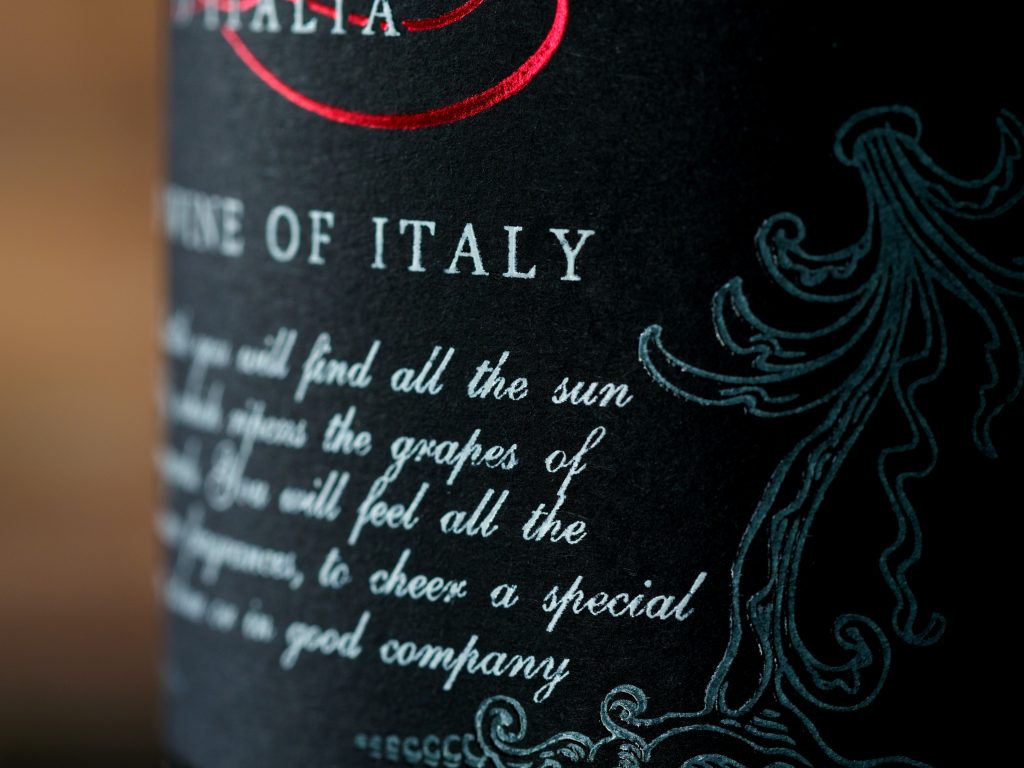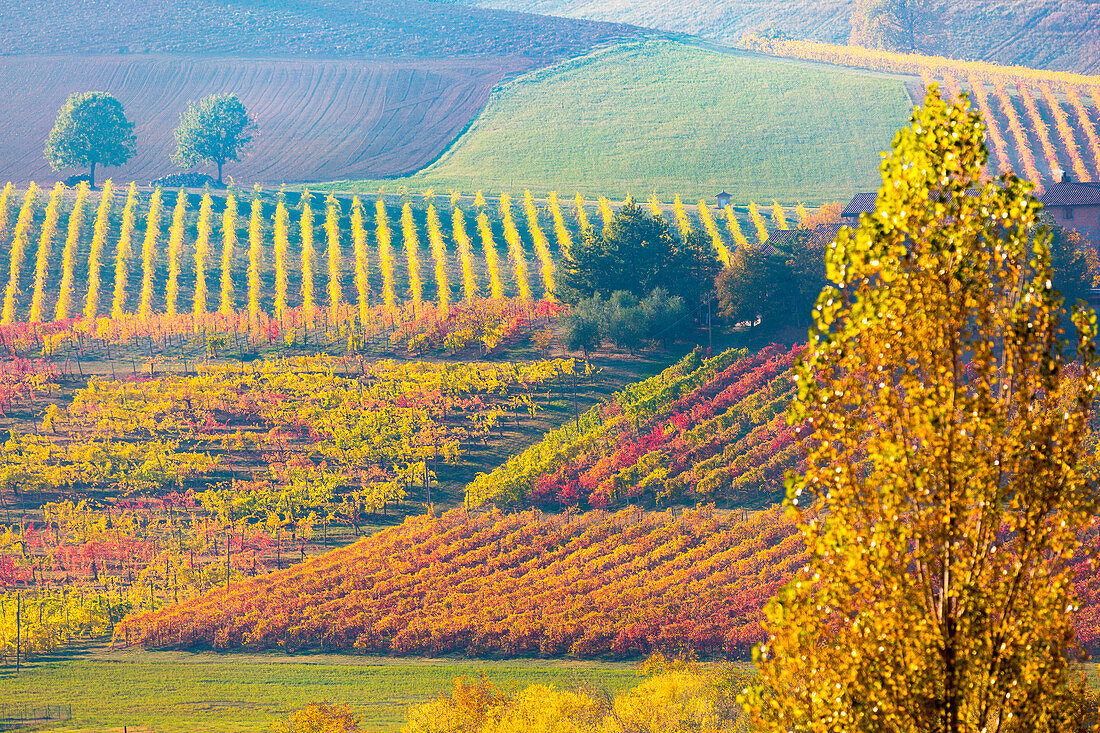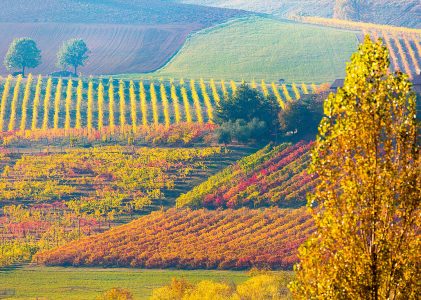Lambrusco is is a frizzante (semi-sparkling) fresh, fruity bubbly red wine, low in alcohol, which in Italy enjoys a great popular tradition.
Coming from one of the most ancient Italian native vines, it is both a type of wine, as well as variety of grape principally grown in the areas of Modena, Parma and Reggio in the Emilia-Romagna region, and Mantova in Lombardy.
The name Lambrusco stems from the Latin terms labrum (edge, margin) and ruscum (spontaneous plant): the Romans adopted the term labrusca to indicate the spontaneous growth of this vine on the perimeters of the fields.
Many wines are made from more than one Lambrusco variety and additionally often blended (to a maximum of 15%) with other grapes, such as Ancellotta.
This fizzy red with purple hues goes well with all the typical dishes of Emilian cuisine: cured meats, first courses with homemade pasta and meat sauce, boiled meats, stews and even creamy cheeses, or just to be sipped solo in all its fizzy glory.
Today, there are various levels of sweetness: on the bottle, look for the designations, from dry (secco) to off-dry (amabile) to sweet (dolce). Wines from Reggiano especially, tend to be amabile in style, meaning you’ll perceive some sweetness on the palate.
The primary flavors of this red Italian wine are floral with scents of violets and red fruits, ranging from red cherries to hints of ripe berries.
While entry-level Lambrusco is typically labelled as IGT, the wine has been classified in several DOCs according to the areas to which the vines belong: in the Province of Modena there are Lambrusco di Modena, Lambrusco di Sorbara, Lambrusco Grasparossa di Castelvetro and Lambrusco Salamino di Santa Croce; in the province of Reggio Emilia there are Lambrusco Reggiano, Lambrusco Montericco Colli di Scandiano and Canossa; in Parma there is Colli di Parma DOC; an eighth DOC is in Lombardy, in the province of Mantova, where Lambrusco Mantovano has its home.
Local aficionados are divided between admirers of the finest Sorbara or delicate Salamino, of the more intense Grasparossa or even the powerful Maestri. Whatever your personal preferences, Lambrusco can be recognized from the very first sip: its freshness, its bubbly foam and its aromas of red fruit leave no doubt.
Lambrusco should be enjoyed young, in the spring following the harvest. Being a light-bodied red it should be served lightly chilled (13 °C-15 or 55 -60°F) and uncorked at the moment, keeping the bottle slightly tilted forward.
LAMBRUSCO DESCRIPTION
The colour and flavour of the wine depend on which of the many Lambrusco grape varieties are used. (The name of the variety is usually on the label.) Overall, it’s usually ruby red and the foam ranges from salmon pink hues in the lighter colored Sorbara to the purplish edges in the Salamino. Grasparossa is invariably dark, redolent of blackberries and, thanks to its tannins, can be suitably matched to hearty food. Salamino, which is often used for blending, yields sturdy wines that are deep pink to purple, with a tannic twist. The dry versions of Reggiano wine are full-bodied and darker with an intense, ruby hue.
The bouquet of the wine is fruity, with a strong scent of violets, which represents the most typical and unmistakable characteristic of Sorbara, as well as orange blossoms, rhubarb, and nuances of ripe berries including raspberries, blackcurrants and blackberries
The peculiar characteristics of these fizzy red wines change from DOC to DOC but are usually fruity and vinous, with a pleasant tartness and a moderate alcohol content. Flavors include fresh and ripe cherries, blackberries strawberries, blueberries and violets intertwining in an harmonious symphony. Grasparossa has structure and noticeable tannins. Sorbara is drier and more acidic. The taste of Salamino is dry, harmonious and medium to full-bodied. This light sparkling wine is usually low in alcohol. Its ABV ranges from 8 to 11%.
LAMBRUSCO GRAPES
The different vines called Lambrusco stem from the domestication of Vitis silvestris, which developed over the millennia through natural selection. There are 56 varieties of Lambrusco red grapes classified into 6 DOCs.
Lambrusco di Sorbara DOC can be produced with a minimum 60% of grapes coming from the homonymous vine and a maximum 40% of Lambrusco Salamino. Other types of Lambrusco can be used up to a maximum of 15%.
The Salamino di Santa Croce DOC comes from the vine with the same name whose bunches are cylindrical and compact, resembling the shape of a salami. According to the regulations, it can be produced with a minimum of 85% of the grapes of the Salamino vine, while for the remaining 15% it’s possible to use other types such as Ancellotta or Fortana.
The Grasparossa di Castelvetro DOC requires at least 85% of the same variety whereas for the production of Lambrusco Reggiano the four grapes that can be used are Maestri, Marani, Montericco, and Salamino.
The variety Maestri is grown in the provinces of Parma and Reggio Emilia, as evidenced by the name “Maestri” which seems to derive from “Villa Maestri”, in the municipality of San Pancrazio in the province of Parma. Lambrusco di Parma IGT must in fact include at least 85% of the Lambrusco Maestri variety which is appreciated for its ability to give color, tannins and body to the wine. These intense ruby-colored wines are known as “dark Lambrusco” and are characteristic of Reggiano and Parmense.
HOW LAMBRUSCO IS MADE
The harvest of Lambrusco grapes happens around early-mid September. The freshly harvested grapes are destemmed and simultaneously pressed; then, they’re transported in large, modern vats where they ferment with the skins in order to get the most intensity in terms of color and flavor.
There are two fermentation methods used to create this cheerful wine, with a lively effervescence that puts a smile on everybody’s face: one is the so called traditional “Ancestrale” method, where the wine is re-fermented in bottle in springtime, after the fermentation was stopped due to the rigid winter temperatures. Once the bottle was uncorked, the foam spontaneously. appeared.
Today, most producers prefer the Italian patented Martinotti-Charmat (tank fermentation) method: the base wine is combined with sugar and natural yeast (Saccharomyces Bayanus) in closed steel tanks with controlled temperature, in order to transform the sugar into alcohol and CO2. The foam is collected naturally using the Charmat method in order to give the wine medium size bubbles under about 2 to 3 atmospheres of pressure.
To produce the sweet styles the alcoholic fermentation is stopped at the decided sugar level thanks to filtering procedures.
LAMBRUSCO FOOD PAIRINGS
Lambrusco unique characteristics result from the extraordinary combination of Emilia-Romagna soil, weather and people: the bubbles of this semi-sparkling wine, which “cleans” the palate at every sip, is the oenological response to the rich Emilian cuisine: it goes perfectly with traditional first courses based on meat sauce such as Lasagne or Tagliatelle or the famous tortellini in broth, or classic boiled meats of pork like zampone with lentils or cotechino as well as the numerous cold cuts of Parma Ham, Salame di Felino, Coppa di Parma or Culatello di Zibello that this land offers.
Its fizzy character makes it perfect as a summer aperitif, especially if served chilled.
Due to its wide variety, the different types of Lambrusco are best suited for pairing with certain dishes: for example, a Grasparossa, with its fuller and more intense body, is more suitable for meat dishes, aged cheeses such as Parmigiano-Reggiano DOC, and elaborate pastas due to its tannic strength, while a Sorbara, thanks to its pronounced aromatic notes, its high acidity and lightness is the ideal companion for fish dishes, cold cuts or fresh cheeses. The “amabile” variety are also a perfect match for pastries and the typical desserts of Modena. Salamino di Santa Croce DOC for its unique fragrance is the ideal accompaniment for appetizers with cured meats as well as with the first courses seasoned with meat sauce.
The joyfulness of its aromas makes it also the perfect match of surprising pairings such as with pizza or the one made famous by the Italian singer Luciano Ligabue: popcorns!
TRY IT OUT!

TOP LAMBRUSCO PICKS
Lambrusco di Sorbara DOC
A dry frizzante that stands outs with firm acidity and aromas of fresh raspberries and violets is Alberto Paltrinieri’s Radice 2016
https://cantinapaltrinieri.it
https://www.vivino.com/paltrinieri-radice/w/1223408
If you want to try a pink version of this slightly fizzy indigenous red wine try Cantina della Volta Brut Rosé (32,27$)
https://cantinadellavolta.com
https://www.vivino.com/it-cantina-della-volta-brut-rose/w/1610628
Lambrusco Salamino di Santa Croce DOC
Among the most notable ones, the bitter profile of Luciano Saetti’s Rosso Viola is worth the price, coming from an old vineyard of 1964, re-fermented in the bottle with disgorgement done manually.
http://www.vignetosaetti.it/index.php/it/
https://www.vivino.com/vigneto-saetti-rosso-viola/w/1468703
Lambrusco di Modena DOC
The Vecchia Modena by Cleto Chiarli, a winery with a centuries-old history, is a refreshing and vibrant ruby-hued frizzante to accompany your meals.
https://www.chiarli.it/it/
https://www.vivino.com/cleto-chiarli-vecchia-modena-lambrusco-di-modena/w/1163590
Lambrusco Grasparossa di Castelvetro DOC
Cleto Chiarli Centenario Lambrusco Grasparossa di Castelvetro Amabile N.V.
has delicate fruit, making it a perfect match for Emilia-Romagna’s lightly sweetened desserts.
https://www.chiarli.it/
https://www.vivino.com/cleto-chiarli-centenario-lambrusco-grasparossa-di-castelvetro-amabile/w/1212065
Lambrusco Emilia IGT
A masterpiece that comes from Lambrusco Maestri variety is the Otello produced by Cantine Ceci: its straightforward fruit and excellent tannins makes it ideal in combination with traditional Parmesan products.
https://www.lambrusco.it
https://www.vivino.com/ceci-otello-lambrusco/w/1150643
TOP LAMBRUSCO VALUES
Lambrusco Emilia IGT
Although it might not be representative of what Italians define the real Lambrusco (medium-dry, acidic with notes of red fruits and violets) the Ariola Lambrusco Marcello Grand Cru stands out for its rich aroma, its roundness and natural expression of the fruit.
https://www.viniariola.com/
https://www.vivino.com/ariola-marcello-lambrusco-gran-cru/w/6379391
The Ceci Terre Verdiane Lambrusco 1813 N.V. is certainly a good match between price and quality: intensely perfumed, on the palate reveals its ripe raspberries and dark plum core.
https://www.lambrusco.it
https://www.vivino.com/ceci-terre-verdiane-lambrusco-1813/w/1150647
Cavicchioli Lambrusco Dolce N.V. is sweet, with more than 45 g/L of residual sugar, but lively and will certainly satisfy your thirst of this famous red bubbly wine.
https://www.gruppoitalianovini.it/index.cfm/it/brand/cavicchioli/
https://www.vivino.com/cavicchioli-lambrusco-dolce/w/1150232
Chiarli 1860 Lambrusco Grasparossa di Castelvetro Amabile N.V. is the wine we want to be sipping all year long with notes of ripe sweet fruits and a pleasant and lasting touch of sweetness.
https://www.chiarli.it/
https://www.vivino.com/chiarli-lambrusco-grasparossa-di-castelvetro-amabile/w/1150039

